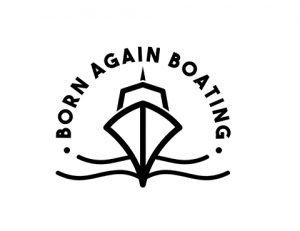Have you ever seen the signs at the gas station fuel pump. You know, the ones that say, “You are responsible for any spills!” That is something that you really don’t ever see. It’s not often that you notice the person next to you filling up their car and shouting in frustration as fuel explodes out of the fill at them! Now on a boat, that is a different story!
Why Does A Boat Fuel Tank Overflow When Filling? Overflow of fuel when filling a boat fuel tank is caused by either a clog in the venting side of the tank, or a blockage in the fuel fill hose.
Though the answer is very simple. There are many different components that can create this issue. Here are the most common ones and what you can do to test them!
Is the Fuel Tank Vent Clogged?
A boat fuel tank overflow can be caused by a clog in the vent. The fuel tank vent is located on the outside of the boat, 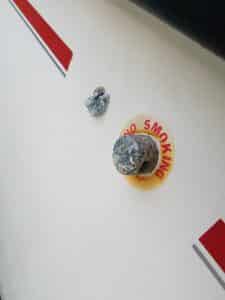 normally relatively close to the fill port on the gunwale of the boat.
normally relatively close to the fill port on the gunwale of the boat.
Taking a look on the outside of the hull and seeing if the vent is even there, if it is corroded, broken, or upside down. With the hole facing towards the sky allowing water to get into it. This will give you a quick idea if it is the problem.
With the fill port cap off. You can try blowing air into the vent from the outside and feel to see if air comes out of the fill port. If you can’t blow any air into the vent, this is the place to start!
Some vents have screens on them which can get salty, dirty, or clog up. Unscrewing the vent or removing the screen, depending on which vent port you have. Will allow you to check this issue.
Find access to the back of the vent to remove the hose in order to confirm that the vent is allowing the free flow of air into the fuel tank venting hose! If you find that it is clogged, just replace the vent port and get back on the water!
Is the Fuel Tank Vent Hose Kinked or Clogged?
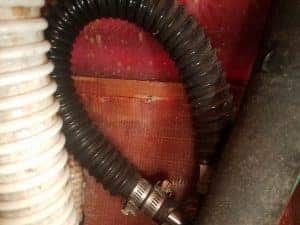 If you find that the fuel tank vent is wide open with no obstruction. Then move onto testing the fuel tank vent hose.
If you find that the fuel tank vent is wide open with no obstruction. Then move onto testing the fuel tank vent hose.
The vent hose should come off of the vent port fitting, facing upward. The hose should make a loop up from the vent and then loop down after that. This ensures that water can not enter into the fuel tank via the vent tube.
Visually look at the vent hose to make sure that it is not kinked anywhere or smashed. You might have to get out a flashlight and a mirror to see down into the gunwale. Then you can even blow on the vent tube just like when testing the vent port.
With the fill cap off, if you still don’t feel any air coming out, and you can’t blow into the hose, then we’ll have to dig deeper to fix this issue.
Is the Fuel Tank Vent Clogged at the Fuel Tank Fitting?
Find the access to the fuel tank fill and vent fittings on top of the fuel tank. Once you get to these hoses, remove the vent hose which is most commonly a 5/8″ vent hose. With the hose off, blow on the other end and see if air comes out.
If air is free-flowing through the hose. We know that the hose and the vent port on the side of the boat are not the problem.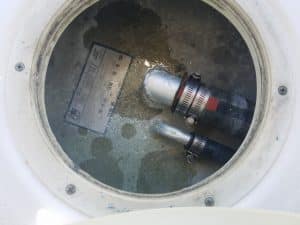
Now, if you do find the hose is kinked or clogged, locate the kink and try moving the hose. Then secure it, to ensure it opens up the venting hose to allow air to move freely.
If not, then grab your flashlight and mirror again and look into the vent fitting on the tank the best you can.
Most vent outlets on boat fuel tanks are built into the tank and are 99% of the time, not the issue. With that said though, if the vent is a screw-in fitting with a 90-degree barb on it. This could be the issue. Carefully unscrew the fitting and inspect it.
If the fitting is clean and nothing clogging it up. The fuel tank vent side of the system is not the problem!
This is either a good or a bad thing. Good because we have confirmed that the venting system is not the issue. Not so good because now we know that there is an issue somewhere on the fill side.
Unless the Boat is Newer and Has a Venting Regulator Installed
On newer vessels, they are adhering to EPA regulations about open-air venting of boat fuel tanks. Different manufactures and boat builders are coming up with different systems in order to adhere to these regulations.
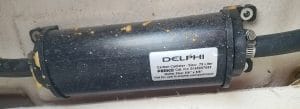 One of the ways is by installing a regulating system into the vent side of the fuel tank system. These regulators can get clogged and create the overflow issue that you are trying to resolve.
One of the ways is by installing a regulating system into the vent side of the fuel tank system. These regulators can get clogged and create the overflow issue that you are trying to resolve.
You will know pretty quickly if your boat has one of these by simply following the fuel vent hose wherever it goes. Probably having to remove different access ports and utilizing the flashlight and mirror system to follow it along!
If you find the regulator, you can disconnect the hose and see if this resolves the issue. Blowing into the hose, you should feel or hear air coming out of the fuel tank fill port with the cap removed.
If so, then you know where the clog is. There are only two options here, replace the regulator, or bypass it.
I would not recommend bypassing it but replacing it. Also, you DO NOT WANT TO LEAVE THE FUEL TANK VENT OPEN INSIDE OF THE BOAT! THIS CAN CAUSE FUEL FUMES TO BUILD UP INSIDE OF A COMPARTMENT AND BECOME AN EXPLOSION SCENARIO IF IGNITED!
Just opening the hatch could allow an explosion, so 100% make sure that the vent is vented to the outside air, outside of the boat.
Hint: why it would be a lot safer to just replace the regulator and figure out why it failed. Staying on the safe side!
Checking the Fill Hose and Port on the Boat.
With the vent side in the free and clear. the fill side of this system is most likely going to be the culprit. Taking the flashlight and mirror, look down the gunwale to see if you can see the fill hose. Sometimes there can be an issue where the hose got pinched when it got put in and now it is sitting there half kinked.
You can also look with the mirror at the fill port on the fuel tank itself. Looking over where the hose goes through the stringer and over to the gunwale.
In the mirror should be a visible kink or smashing of the hose. Confirming the location of the issue that is making the boat fuel tank overflow when you are filling it.
In order to fix this problem though, you will have to move the hose somehow to relieve the pressure on the hose, taking the kink or smash out of the hose. If this can’t be done, then you can try replacing the hose.
Worst Case Scenario!
Replacing the hose could turn into a real headache. It could get expensive if you are going to pay someone to do it as well.
In the end, you might be stuck filling your boat fuel tank very slowly to avoid the overflow! Which can be a pain, but it might beat spending a bunch of money just to save those couple minutes at the gas pump.
Hopefully, this gave you a better understanding of why a boat fuel tank overflows when filling up and how to get through the testing and fixing of the issues.
Something else you might find very useful is an article that we wrote describing What Exactly Ethanol Fuel Does To Your Engine & How To Burn It Safely!
We upload outboard how-to and DIY boating videos weekly on our YouTube Channel at Born Again Boating! Check us out and make sure you get subscribed to let us help you get through all of your boating endeavors!
If you’ve got any questions or comments, let us know by subscribing to our YouTube Channel!
And if you would like to support us to continue bringing you great content, please click the link below to Amazon where we get a commission from anything you are already going to buy!
Click Here To Amazon!
And you can also donate by clicking the donate button here or on the right hand of the screen!
It really helps us out and we thank you so much for your support!
Thanks for reading and we look forward to reading your responses and comments.
If you’d like us to cover something, or you have any questions about your boat. Just drop a comment in the section below and we’ll do our best to get you pointed in the right direction!
